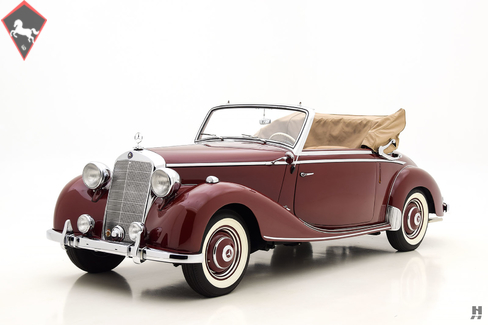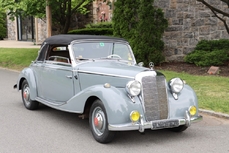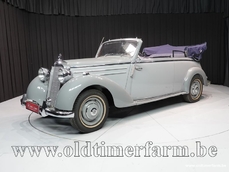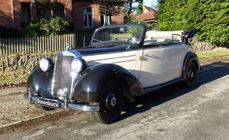Mercedes-Benz 170S Cabriolet 1951
Allgemeine Beschreibung :
Mercedes-Benz has been a manufacturing powerhouse for over a century, and during World War II, its factories were highly valuable targets for Allied bombers. Many of their manufacturing and design facilities were heavily damaged, but despite this, the company was quick to resume automobile production after the war. The first post-war cars were the W136 170 V sedans which traced their roots back to the late 1930’s. These bread-and-butter sedans served as solid, reliable transportation in the austere post-war years and became popular with taxi and delivery drivers. But as Europe recovered and production of the 170 V increased, so too did demand for more luxurious and special models. To meet this demand, the 170 S was introduced. The first special-class car to be built by Mercedes-Benz after the War; the 170 S had a more powerful engine than the 170 V, as well as improved front suspension, revised styling and a more luxurious and spacious cabin. Power came from an uprated version of the 1.7 liter inline four-cylinder engine, producing 53 horsepower and 82 ft-lbs or torque. The 170 S was offered as a handsome saloon, full four-seat Cabriolet B and sporty Cabriolet A. Open cars were meticulously hand-built at Mercedes’ Sindelfingen Carrosserie, where they were luxuriously trimmed with leather and wood. While Mercedes was still many years away from officially designating “S-Class” as its flagship range, many feel that the 170 S is its spiritual predecessor. With the 170 S, Mercedes-Benz had marked its return to the top of the luxury motorcar market.
This outstanding 1951 170 S is from the final year of production, one of just a handful sold that year with the highly desirable Cabriolet A coachwork by Sindelfingen. A gorgeous car from top to bottom, it has been treated to a concours-quality restoration with meticulous attention to detail. Copies of the original build sheets and documents show this car was ordered in July of 1951. Upon its completion, it was dispatched from the Sindelfingen Werk, bound for Zurich Switzerland. Swiss import documents dated March 28th 1952 show it was delivered to Herr Ernst Benz. Not long after, the Mercedes was purchased in Switzerland by an American Army officer, and it eventually made its way to the United States. In about the mid-1960s, it was purchased by Richard A. Carlson of Coatesville, Pennsylvania who kept it for approximately 20 years. The next owner was Mr. Walter Progner who purchased the car in 1984, and is the man who eventually embarked on a multi-year restoration to return this fine motor to its former glory.
These early post-war Mercedes-Benz automobiles are extremely difficult and costly to restore properly, and as such, we seldom see them given the treatment they deserve. Thankfully, Mr. Progner was a passionate enthusiast who lavished the little Mercedes with tremendous care. As the restoration commenced, the chassis and mechanicals were entrusted to Gerhardt Reinhard, proprietor of a small shop in Pennsylvania that specializes in classic Mercedes-Benz automobiles. Mr. Reinhard was himself an employee of the Sindelfingen Werk during the time this car was built – making it entirely possible he had a hand in its original construction and its restoration! Concurrently, the body and interior were restored over a three year period by Barry Stalnecker of Annville, PA, while the extensive brightwork was restored to concours standards by Martin’s of Philadelphia.
The results of the restoration speak for themselves. Paintwork has been restored to the original shade of maroon (DB 513), and is beautifully applied showing straight, clean reflections and glassy-smooth surfacing. As part of the restoration, the body was removed from the chassis, jigged and disassembled. These are notoriously difficult to align properly, and the restorers did an exemplary job refitting the panels. The rear-hinged doors fit very well, with even gaps and the signature solid-hewn feel that is unmistakable Mercedes-Benz. Fitment of the extensive chrome trim is excellent, and even upon close inspection, reveals virtually flawless finishing. Interesting details include the semaphore turn signals, and the flush fit tail lamps. Most 170s had bullet-type tail lights, but this being a late production example; it features the flush-mounted units that were carried over into the later 220 S and 300 S models.
Of course, the signature of the 170 S was the luxuriously trimmed interior. Again, using the build sheet as a reference, this car was restored using natural tan leather supplied by a German restoration specialist. The material is exquisite and unmarked, expertly fitted to the frames. The folding, occasional rear seats are also trimmed in the same high quality leather, as are the door cards and even the fascia of the dash. Caramel-colored carpets tie in beautifully with the natural leather, again very nicely executed, in excellent condition and in factory correct materials. Leaving no screw unturned, the restorers returned the wood, which adorned the dash, door caps and cockpit surround, to its original natural finish. Interior chrome fittings are beautiful, and the dash is equipped with its correct VDO instrumentation and a most wonderful, original Telefunken Radio. The fully-lined cabriolet top features large chrome landau bars and is trimmed in correct tan German Sonnendeck canvas.
The trunk is detailed with a correct spare wheel, original tool roll and jack as well as a 2 piece set of fitted luggage, held in situ with leather straps. Beneath the bonnet, the engine is well detailed, showing only the lightest signs of use, but remaining in very clean and tidy condition. Despite its modest horsepower and pre-war era roots, the engine is a strong and eager unit, delivering performance that is brisk and enjoyable. Road manners are excellent, as this car has received some recent servicing and sorting. The history is very well documented with copies of the rare original build sheet, early customs documents, and extensive restoration records. Original service manuals, parts books and instruction books are included as is an original dealer brochure and show records. Shown multiple times at the world famous AACA Eastern Fall Meet, best known as "Hershey", this fabulous car was awarded an AACA Senior award in 2009, and an AACA Preservation award in 2012. It has also been shown on the lawn of the prestigious Amelia Island Concours d’Elegance in 2013.
This superb Mercedes-Benz 170 S has been cherished by its previous owners, and the quality of the restoration speaks to its importance in the collector world. Just over 800 units of the 170 S Cab A were produced between 1948 and 1951, and this is one of the last of last Mercedes to be truly hand-built in the historic Sindelfingen works; a very special and highly desirable motorcar from Mercedes’ golden era.
Offers welcome and trades considered
1951 Mercedes-Benz 170S Cabriolet is listed zu verkaufen on ClassicDigest in St. Louis by Hyman Ltd. for $175000.
Fakten der Auto
Karosserietyp : Auto Marke : Mercedes-Benz Modell : 170S Ausführung : Cabriolet Hubraum : 0.0 Modelljahr : 1951 Karosstyp : Convertible Lage : Missouri Fahrzeug Anmeldung : Undefiniert
175000 $
People who viewed this Mercedes-Benz 170S also viewed similar Mercedes-Benz listed at ClassicDigest
Other cars listed for sale by this dealer
über Mercedes-Benz
In den Annalen der Automobilgeschichte entfaltet sich die Reise von Mercedes-Benz wie eine Erzählung voller Ingeniosität seiner Gründer. Im Jahr 1886 schuf Karl Benz den Benz Patent Motorwagen, eine Kreation, die als das weltweit erste Automobil in die Geschichte eingehen sollte. Unwissentlich markierte dieser Moment den Ursprung dessen, was sich zu einem weltweit renommierten Premium-Autohersteller entwickeln würde. Die finanzielle Basis dieses bahnbrechenden Unternehmens wurde interessanterweise von Karls Ehefrau, Bertha Benz, bereitgestellt, was eine bemerkenswerte Partnerschaft demonstrierte, die den Ton für das Erbe von Mercedes-Benz setzen sollte.Nicht weit entfernt entstand eine parallele Erzählung, als die Daimler-Motoren-Gesellschaft, gegründet von Gottlieb Daimler und Wilhelm Maybach, die Bühne betrat. Im Jahr 1901 enthüllten sie ihr Auto unter dem mittlerweile berühmten Namen "Mercedes", was auf Spanisch "Geschenk Gottes" bedeutet. Dieser Name wurde auf das Auto auf Wunsch von Emil Jellineks Tochter verliehen, dem Vertriebspartner der Daimler-Motoren-Gesellschaft. Die Räder der Innovation wurden in Bewegung gesetzt.
Springen wir vorwärts ins Jahr 1926, ein entscheidendes Jahr, das die Fusion von Daimler mit Benz & Cie. sah, was zur Geburt von Daimler-Benz führte. Die Fusion führte zur Übernahme von "Mercedes-Benz" als das renommierte Markenzeichen für ihre Automobile und verschmolz die Legenden zweier visionärer Unternehmen zu einer.
Entgegen konservativen Wahrnehmungen entfaltet sich die Geschichte von Daimler-Benz als Chronik von Branchenneuheiten. Von der Einführung des Wabenkühlers über den Schwimmervergaser bis zur bahnbrechenden Einführung von Vierradbremsen im Jahr 1924 trieb Daimler-Benz kontinuierlich die Grenzen der automobilen Innovation voran. Der Dieselantrieb des Mercedes-Benz 260 D im Jahr 1936 markierte den Beginn von Dieselmotoren in Personenkraftwagen. Der ikonische Mercedes-Benz 300SL Gullwing schrieb Geschichte als das erste Auto mit direkter Kraftstoffeinspritzung, wenn auch der winzige 2-Takt-Motor des Gutbrod Vorrang beanspruchen kann.
Sicherheitsinnovationen wurden zum Markenzeichen, mit Béla Barényis patentiertem Sicherheitszellen-Design in den "Ponton"-Modellen im Jahr 1951, das Front- und Heck-Knautschzonen umfasste. Der W116 450SEL 6.9 führte die Einführung des Antiblockiersystems (ABS) ein, eine weitere wegweisende Sicherheitsfunktion. Vom ersten serienmäßigen Airbag bis hin zu vielen weiteren Innovationen wurde das Erbe der "Ersten" weiter in das Gewebe von Daimler-Benz eingeschrieben.
Auf seiner über hundertjährigen Reise hat Mercedes-Benz nicht nur Autos produziert, sondern automobile Ikonen geschaffen. Der SSKL, 710 SSK Trossi Roadster, 770K Grosser, 540K Spezial Roadster, 300SL Gullwing, W100 600 Pullman, W111 280SE 3.5 Flachkühler, W113 230SL Pagode, W109 300 SEL 6.3 und W201 2.3-16 Cosworth sind Zeugnisse des Engagements der Marke für Ingenieurkunst.
Die donnernden Silberpfeile, oder "Silberpfeile", darunter der W 25, W 125, W154, W165 und W196, schufen ein Erbe der Dominanz auf der Rennstrecke. Diese Maschinen waren nicht nur Autos; sie waren Ausdruck von Präzision, Geschwindigkeit und einem unbezwingbaren Geist, der die Konkurrenz im Staub zurückließ.
Während Mercedes-Benz in die Zukunft schreitet, tut es dies nicht nur als Automobilhersteller, sondern als Hüter eines Erbes, als Fackelträger der Innovation und als Leuchtturm automobiler Exzellenz. Der Weg in die Zukunft wird zweifellos die Fortsetzung der Verschmelzung von modernster Technologie, zeitlosem Design und dem unerschütterlichen Engagement für die Festlegung neuer Standards in der Welt der Automobile erleben.

























